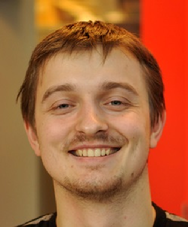Acoustic droplet vaporization
Promotion date: August 28.
Promotors: Prof. dr. Michel Versluis
Prof. dr. ir. Nico de Jong
| Nanodroplets of a size of 100 nm can extravasate through leaky vessels of a tumor, and the drug can be released upon triggering with diagnostic ultrasound while an explosive evaporation of the droplet takes place. This is a promising strategy for local drug delivery, for example in future tumor chemotherapy. Experiments have shown that vapor bubble formations are governed by a complex interaction between droplet and ultrasound. The combined effect of pressure, dissolved gas concentration and local temperature contributes to the cavitation process. In this work ultra-high speed optical imaging is used to study the acoustic droplet vaporization dynamics at nanoseconds timescales, for the first time. A simple theoretical model is developed to capture growth dynamics and the nucleation events. The evaporation process turns out to be limited by the heat transfer necessary for the phase conversion. A long-standing puzzle is explained, namely: how ultrasound can physically trigger the vaporization given the large mismatch between ultrasound wavelength and microdroplet size. It is shown that the vaporization is preceded by nonlinear propagation of the ultrasound wave, generating superharmonics. These high-frequency waves focus efficiently within the droplet, triggering vaporization. Therefore it is concluded that acoustic droplet vaporization possesses great potential for advanced medical diagnosis and therapy. This new understanding allows for further reduction of the required pressure amplitudes, minimizing the adverse effects on healthy tissue. |
Was your work application driven?
My main inspiration for working on this topic was its potential in future applications. Some thirty years ago, ultrasound contrast agents (UCAs) appeared to be of special use for medical imaging. UCAs are micron-sized coated gas bubbles which scatter ultrasound much more efficiently than surrounding tissue.
Liquid nanodroplets are smaller in size than UCAs and can be activated by ultrasound and converted to gas bubbles at will and selectively, for instance, at a tumor site. This opens up new application domains both in imaging and in therapy.
A lot of importance is attached to this field of research worldwide, this being the second reason why I choose this topic. I guess at least fifteen years will pass before the first products based on these droplet characteristics, will become available on the market. The permission for medical use of new treatments and medications are very strict.
Do you recall some special moments during your PhD period?
In fact, all the brainstorm sessions with my supervisors and group leaders Michel Versluis, Nico de Jong, Detlef Lohse and Andrea Prosperetti were. We had very lively discussions in which all breaking ideas popped up and were developed further.
I was very happy in succeeding in my main task, to explain why droplets vaporize by using ultrasound. I was able to come up with the explaining mechanisms, solving the 10-years mystery why high frequencies facilitate this process more than low frequencies do. The secret is that droplets function like a little lens for ultrasound waves, focusing them inside the droplet sphere. I underlined the importance of the ultrasound nonlinear propagation effect occurring in water and in blood to this focusing phenomena
In which journals have you published your findings?
The most proud I am on the article in PNAS (Proceedings of the National Academy of Sciences). Also articles appeared in more specialized journals such as: The Journal of the Acoustical Society of America, and Ultrasound in Medicine and Biology. Also a chapter was submitted to a book on Therapeutic Ultrasound.
What are your future plans?
I found a job at ASML, a leading provider of lithography systems for the semiconductor industry, as a performance analyst. The job is quite different from that of a fundamental physicist, of course, but analytical thinking and combining different kind of data, involving machine as well as human performance, is a very challenging task.
I like the research element in this: predicting things to happen and perform experiments to see the outcome, is always a pleasure to me. In industry these outcomes are likely to be used within a year, benefiting other people, which is very important to me. Whereas in academic research the application horizon is further in time and more abstract. I hope to get nice opportunities within ASML to further develop my career.
Did you feel part of the Mesa+ community in your PhD job, or were you merely focused on the work and colleagues within your research group?
The collaboration within Mesa+ was very important for my research project. The microfluidic expertise and lab facilities were crucial for my experiments, in which the repeatability of monodisperse droplet sizes had to be guaranteed.
The work of Lingling Shui from the Bios Lab-on-a-Chip Group was excellent. She fabricated special chips which allowed me to produce sub-micron sized monodisperse droplets for my purposes.
What, in your opinion, is important for Mesa+ to stay successful in future?
It is important to consistently advertise and attract talented students, PhD-candidates, post-docs and researchers. This can be done on conferences, scientific websites, via networks of researchers and professors and in selecting master, even bachelor students. Highly selected, talented researchers are at the core of success for a renowned institutions like Mesa+.
Although it costs money, I am in favor of a partially sponsored mastertrack, to be offered to talented bachelor students. Scholarships could be offered on combined subjects on physics, nanosience & technology, and technical aspects of nano-research. Personally I serve as an example for doing so, as I was granted a scholarship at the Zernike Institute for Advanced Materials in Groningen where I was rewarded a two-year scholarship, the Top Master Program in Nanoscience. The courses in the nanolab were very inspiring, and I remember them very well. Fellow students were very successful in their later careers, working at top universities like Cambridge, or publishing in top journals like Nature. During this master period I already published two articles myself, paving the path for a successful PhD period.

